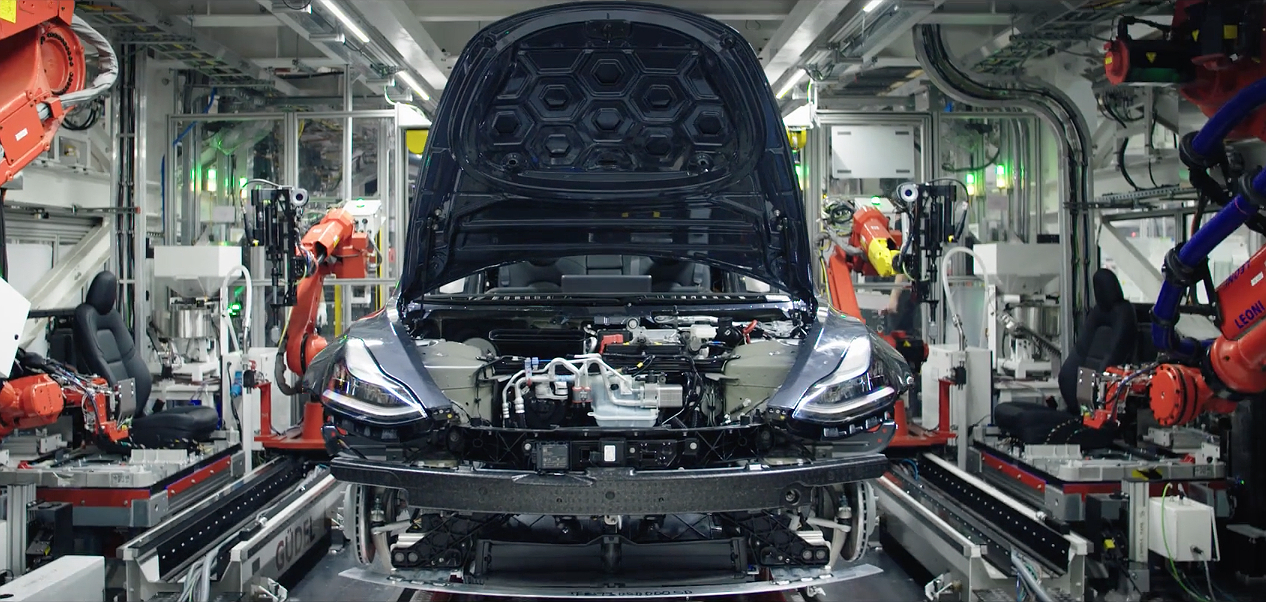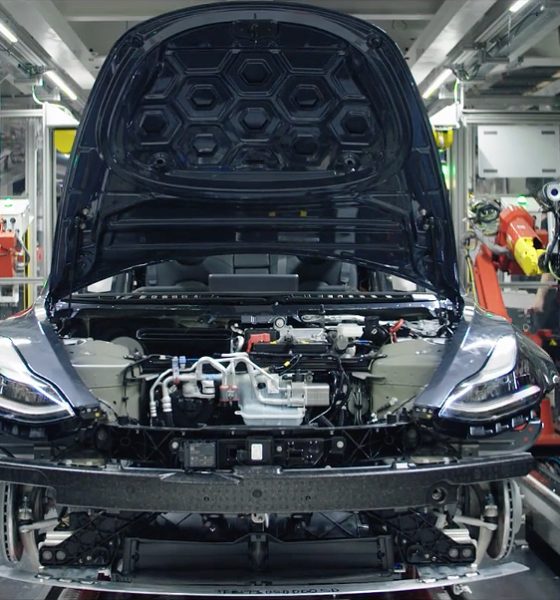

Investor's Corner
Tesla to sustain Model 3 “burst” production rate in July, suggests online tracker
Tesla’s capability to sustain its rate of manufacturing 5,000 Model 3 per week this third quarter remains in question, but an online tracker by Bloomberg suggests that the Silicon Valley electric car maker is on pace to hit peak production levels in the next few weeks.
Tesla was finally able to manufacture 5,000 Model 3 per week during the final seven days of the second quarter, thanks to a blitz of activity in the Fremont factory. Tesla had to implement a number of unorthodox strategies to achieve the production milestone, including building an entirely new general assembly line inside a massive sprung structure at the grounds of the Fremont factory and air-freighting six airplanes’ worth of robots from Europe. These, together with Tesla’s “burst” build, were considered by critics to be unsustainable.
Doubts about Tesla’s capability to maintain its 5,000/week Model 3 production rate fueled the thesis of the company’s most vocal critics, such as JP Morgan analyst Ryan Brinkman, who wrote that Tesla’s burst production could not be repeated. CFRA Research analyst Efraim Levy also downgraded TSLA to a Sell, stating that the burst rate for Model 3 production is the not “operationally or financially sustainable.” These reservations affected Tesla’s stock (NASDAQ:TSLA), with the company ending the week at $308.88 per share, a significant drop from the near-record highs it achieved earlier in June.
Bloomberg’s Tesla Model 3 tracker as of 7/9/18. [Credit: Bloomberg]
If the current numbers reflected in Bloomberg‘s Model 3 online tracker are any indication, however, it appears that Tesla might just be on track to produce the Model 3 at a sustained rate of the 5,000 vehicles per week. As of this weekend, the online tracker, which was just 2% off its prediction for Tesla’s final Q2 numbers, shows a trend of more than 5,000 Model 3 per week over the next three weeks. Apart from this, production of the compact electric car is also listed at 5,187 Model 3 per week.
Bloomberg‘s Tesla Model 3 production tracker aggregates data from U.S. government resources, social media reports, as well as direct communication with Tesla owners. VINs that are listed in the tracker are either traced depending on Tesla’s own filings during batch registrations, or sightings of Model 3 in the wild. Vehicle Identification Numbers do not directly correspond to the number of Model 3 that Tesla is producing, but Elon Musk himself admitted in the Q1 2018 earnings call that “any information that (Tesla) provide(s) would be one week or two in advance of what will become public knowledge just due to vehicle registrations and shipments that are tracked very carefully.”
Tesla is now attempting to hit sustained profitability for the first time in its history. During Q2 2018, Elon Musk boldly declared on Twitter that Tesla would start being profitable around Q3 or Q4 2018. During the first quarter earnings call, Musk reiterated this, stating that it was about time Tesla starts showing some earnings. In order to accomplish this goal, Tesla would have to ensure that the Model 3 gets built and delivered at a pace that is sustainable.
Considering the sales numbers of the Model 3, it appears that if Tesla can keep its production rate steady, it would only be a matter of time before the vehicle can help push the company towards profitability. In Tesla’s Q2 2018 Production and Delivery report, the company stated that it had delivered 18,440 Model 3 from April-June 2018. Tesla also had 11,166 Model 3 vehicles in transit to customers by the time the quarter ended, setting up the third quarter for record deliveries and sales. The Chevy Bolt EV, considered as the Model 3’s main rival, had sales of 3,483 vehicles during Q2 2018, 82% less than the Model 3.

Investor's Corner
SpaceX IPO is coming, CEO Elon Musk confirms
However, it appears Musk is ready for SpaceX to go public, as Ars Technica Senior Space Editor Eric Berger wrote an op-ed that indicated he thought SpaceX would go public soon. Musk replied, basically confirming it.

Elon Musk confirmed through a post on X that a SpaceX initial public offering (IPO) is on the way after hinting at it several times earlier this year.
It also comes one day after Bloomberg reported that SpaceX was aiming for a valuation of $1.5 trillion, adding that it wanted to raise $30 billion.
Musk has been transparent for most of the year that he wanted to try to figure out a way to get Tesla shareholders to invest in SpaceX, giving them access to the stock.
He has also recognized the issues of having a public stock, like litigation exposure, quarterly reporting pressures, and other inconveniences.
However, it appears Musk is ready for SpaceX to go public, as Ars Technica Senior Space Editor Eric Berger wrote an op-ed that indicated he thought SpaceX would go public soon.
Musk replied, basically confirming it:
As usual, Eric is accurate
— Elon Musk (@elonmusk) December 10, 2025
Berger believes the IPO would help support the need for $30 billion or more in capital needed to fund AI integration projects, such as space-based data centers and lunar satellite factories. Musk confirmed recently that SpaceX “will be doing” data centers in orbit.
AI appears to be a “key part” of SpaceX getting to Musk, Berger also wrote. When writing about whether or not Optimus is a viable project and product for the company, he says that none of that matters. Musk thinks it is, and that’s all that matters.
It seems like Musk has certainly mulled something this big for a very long time, and the idea of taking SpaceX public is not just likely; it is necessary for the company to get to Mars.
The details of when SpaceX will finally hit that public status are not known. Many of the reports that came out over the past few days indicate it would happen in 2026, so sooner rather than later.
But there are a lot of things on Musk’s plate early next year, especially with Cybercab production, the potential launch of Unsupervised Full Self-Driving, and the Roadster unveiling, all planned for Q1.
Investor's Corner
Tesla Full Self-Driving statistic impresses Wall Street firm: ‘Very close to unsupervised’
The data shows there was a significant jump in miles traveled between interventions as Tesla transitioned drivers to v14.1 back in October. The FSD Community Tracker saw a jump from 441 miles to over 9,200 miles, the most significant improvement in four years.

Tesla Full Self-Driving performance and statistics continue to impress everyone, from retail investors to Wall Street firms. However, one analyst believes Tesla’s driving suite is “very close” to achieving unsupervised self-driving.
On Tuesday, Piper Sandler analyst Alexander Potter said that Tesla’s recent launch of Full Self-Driving version 14 increased the number of miles traveled between interventions by a drastic margin, based on data compiled by a Full Self-Driving Community Tracker.
🚨 Piper Sandler reiterated its Overweight rating and $500 PT on Tesla $TSLA stock
Analyst Alexander Potter said FSD is near full autonomy and latest versions showed the largest improvement in disengagements, from 440 miles to 9,200 miles between critical interventions pic.twitter.com/u4WCLfZcA9
— TESLARATI (@Teslarati) December 9, 2025
The data shows there was a significant jump in miles traveled between interventions as Tesla transitioned drivers to v14.1 back in October. The FSD Community Tracker saw a jump from 441 miles to over 9,200 miles, the most significant improvement in four years.
Interestingly, there was a slight dip in the miles traveled between interventions with the release of v14.2. Piper Sandler said investor interest in FSD has increased.
Full Self-Driving has displayed several improvements with v14, including the introduction of Arrival Options that allow specific parking situations to be chosen by the driver prior to arriving at the destination. Owners can choose from Street Parking, Parking Garages, Parking Lots, Chargers, and Driveways.
Additionally, the overall improvements in performance from v13 have been evident through smoother operation, fewer mistakes during routine operation, and a more refined decision-making process.
Early versions of v14 exhibited stuttering and brake stabbing, but Tesla did a great job of confronting the issue and eliminating it altogether with the release of v14.2.
Tesla CEO Elon Musk also recently stated that the current v14.2 FSD suite is also less restrictive with drivers looking at their phones, which has caused some controversy within the community.
Although we tested it and found there were fewer nudges by the driver monitoring system to push eyes back to the road, we still would not recommend it due to laws and regulations.
Tesla Full Self-Driving v14.2.1 texting and driving: we tested it
With that being said, FSD is improving significantly with each larger rollout, and Musk believes the final piece of the puzzle will be unveiled with FSD v14.3, which could come later this year or early in 2026.
Piper Sandler reaffirmed its $500 price target on Tesla shares, as well as its ‘Overweight’ rating.
Investor's Corner
Tesla gets price target boost, but it’s not all sunshine and rainbows

Tesla received a price target boost from Morgan Stanley, according to a new note on Monday morning, but there is some considerable caution also being communicated over the next year or so.
Morgan Stanley analyst Andrew Percoco took over Tesla coverage for the firm from longtime bull Adam Jonas, who appears to be focusing on embodied AI stocks and no longer automotive.
Percoco took over and immediately adjusted the price target for Tesla from $410 to $425, and changed its rating on shares from ‘Overweight’ to ‘Equal Weight.’
Percoco said he believes Tesla is the leading company in terms of electric vehicles, manufacturing, renewable energy, and real-world AI, so it deserves a premium valuation. However, he admits the high expectations for the company could provide for a “choppy trading environment” for the next year.
He wrote:
“However, high expectations on the latter have brought the stock closer to fair valuation. While it is well understood that Tesla is more than an auto manufacturer, we expect a choppy trading environment for the TSLA shares over the next 12 months, as we see downside to estimates, while the catalysts for its non-auto businesses appear priced at current levels.”
Percoco also added that if market cap hurdles are achieved, Morgan Stanley would reduce its price target by 7 percent.
Perhaps the biggest change with Percoco taking over the analysis for Jonas is how he will determine the value of each individual project. For example, he believes Optimus is worth about $60 per share of equity value.
He went on to describe the potential value of Full Self-Driving, highlighting its importance to the Tesla valuation:
“Full Self Driving (FSD) is the crown jewel of Tesla’s auto business; we believe that its leading-edge personal autonomous driving offering is a real game changer, and will remain a significant competitive advantage over its EV and non-EV peers. As Tesla continues to improve its platform with increased levels of autonomy (i.e., hands-off, eyes-off), it will revolutionize the personal driving experience. It remains to be seen if others will be able to keep pace.”
Additionally, Percoco outlined both bear and bull cases for the stock. He believes $860 per share, “which could be in play in the next 12 months if Tesla manages through the EV-downturn,” while also scaling Robotaxi, executing on unsupervised FSD, and scaling Optimus, is in play for the bull case.
Will Tesla thrive without the EV tax credit? Five reasons why they might
Meanwhile, the bear case is placed at $145 per share, and “assumes greater competition and margin pressure across all business lines, embedding zero value for humanoids, slowing the growth curve for Tesla’s robotaxi fleet to reflect regulatory challenges in scaling a vision-only perception stack, and lowering market share and margin profile for the autos and energy businesses.”
Currently, Tesla shares are trading at around $441.








